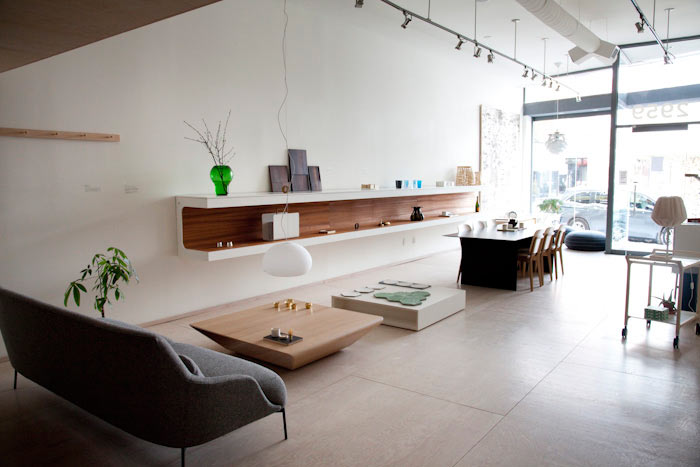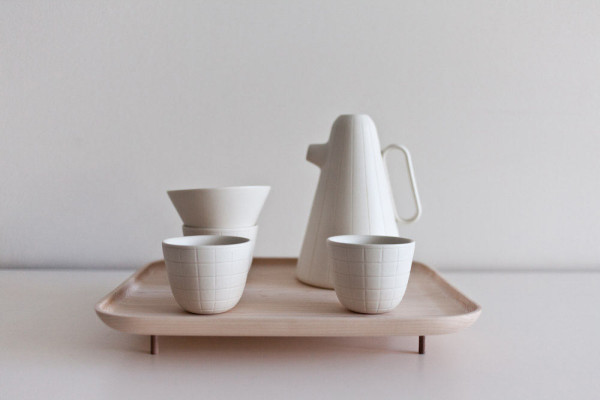Wander around the Junction neighborhood of Toronto and you’ll discover Mjölk, a unique store that merges Scandinavian and Japanese design. Yes, please!
Started in 2009 by husband and wife team John and Juli Daoust, Mjölk (which means “milk” – hey! We like that!), is both a gallery exhibiting work by both artists and artisans from Scandinavia and Japan, and also a lifestyle store. A double whammy of art and design awesomeness and a must-visit when in Toronto. We talked with John and Julie about the shop:
Why did you pick this city/neighborhood/storefront?
Our shop is located in the Junction neighborhood of Toronto, an area in the West-end of the city, which has slowly transformed from a rough neighborhood into a interesting and creative part of the city. We purchased the building in 2009 and opened the retail shop on the first floor and made the apartment above the shop our home.
Where did you get the name for the store?
The name Mjolk means, “milk” in Swedish. It’s a word that incorporates a lot of traits we admire in good design; it is pure, essential, and democratic. The milk packaging in Sweden is very well designed, especially the Arla milk carton which features minimalist red bars, a black cow and clean type. Swede’s are the highest milk drinkers per capita in the world; so we imagine a well-designed milk carton in almost everyone home in Sweden. It is an example of something very simple, very democratic with an exceptional design.
Has it changed much since it opened? How?
When we opened we had a strong focus on both Nordic and Japanese designers, artisans, and furniture makers. Now we have work from America, Spain, and Italy. The world has become very international place, an Italian designer like Luca Nichetto is living in Sweden and designing for many different companies around the world. I like to see an Italian designer work for a Danish company, and see how two opposing styles can create something very unique. These examples are some of the most exciting the design world has ever seen and is something very true to life right now.
What’s one of the challenges you have with the business?
I think being known as the “Scandinavian” shop in our city can be challenging. We don’t carry the standard items like an Arne Jacobsen Swan chair, or the Hans Wegner Wishbone chair. These are things readily available and very mainstream mid-century designs. Instead, we want to offer more of a mix of contemporary and classic designs by designers that are maybe not as well known but incredibly important.
What other stores have you worked in before opening this one?
We both come from different backgrounds that are not exactly related to the store but in a way complimentary. Juli worked as a photographer, and in publishing. John worked at an advertising agency and a custom furniture maker in Toronto.
What’s your favorite item in the store right now?
The Sucabaruca coffee set by Luca Nichetto which was designed for our store and is produced right here in Toronto. It is a “hand-pour” coffee set whose cone-shaped body is reminiscent of “Carmencita”, the famous character created by Armando Testa in 1966 for the TV show “Carosello”.
What is this season’s theme/inspiration/story?
We always think of the store as a “Canadian” aesthetic, so we try to take elements from Scandinavia and Japan and tie them to Canada by mixing the store with plants, flowers, rocks, birch bark and other natural things found from our landscape. Self-identity is a common theme in Canada in general.
Are you carrying any new products and/or undiscovered gems you’re particularly excited about?
We are really happy to be able to invite many artisans from Japan and host exhibitions of their work. Over the summer we hosted perhaps the most famous wood artisan in Japan – Ryuji Mitani.
It was his first solo exhibition outside of Japan, and along with displaying and selling his hand made works, we hosted a spoon carving workshop with him in our home above the shop.
What’s been a consistent best seller?
We have a handful of products that we have carried since the first day we opened the store, and a collection of designs that are very special to us is the work by Japanese designer Oji Masanori. We were the first to carry his works outside of Japan, and have since hosted two solo exhibitions of his collection. The Kami mug has been a consistent good seller for us. It is made by a single craftsman named Takahashi Hidetoshi in Asahikawa Japan. It’s wooden walls insulate coffee or tea keeping them hotter for longer.
Does the store have its own line?
We have our own collection of home products, as well as a series of books and exhibition catalogs that we publish. We have produced a milk and sugar set with brass and wood tray by Swedish architect firm Claesson Koivisto Rune, as well as a coffee and tea service by Luca Nichetto and cabinets by Studio Junction architects. We will be expanding our in house design collection in 2015 to include a watering can, herb pots, water savers, and jewelry.
Any special events/exhibits/pop ups/collaborations coming up?
We have a solo exhibition of Norwegian design firm Anderssen Voll in conjunction with Toronto Design Week 2015. We will be showing their most iconic works, as well as reveal a new collaborative product that will be manufactured in Toronto.
Do you have anything from the store in your own home?
We are perhaps our own best customer haha. One of our favorite pieces in a natural vegetable tanned leather leather by Borge Mogensen, which sits in our living room.
What’s next for you and your store?
We hope to keep expanding the Mjolk Made collection in the future; We want to create a collection of goods that are exceptionally functional, smartly designed and with an emphasis on craft. This is something that is difficult to produce, but we hope people will understand and appreciate what we are trying to do.
Visit Mjölk at 2959 Dundas St W, Toronto Canada or online here.


























